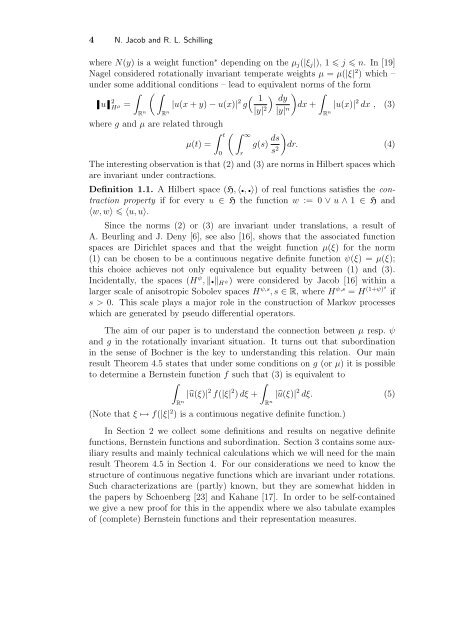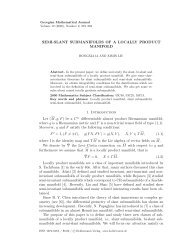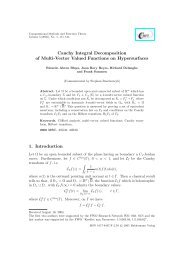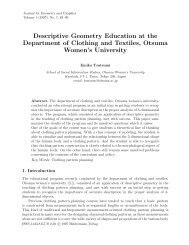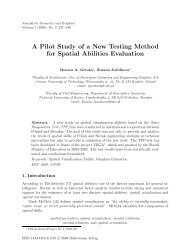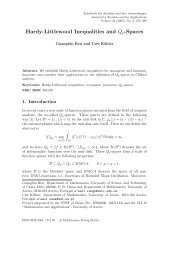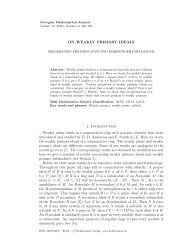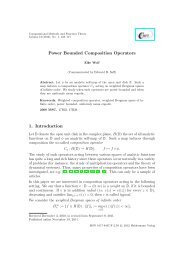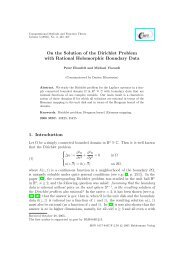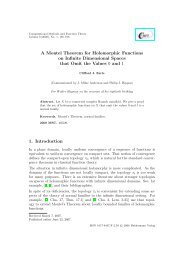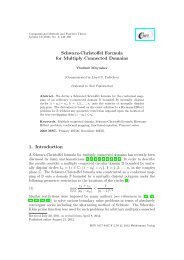Function Spaces as Dirichlet Spaces (About a Paper by Maz'ya and ...
Function Spaces as Dirichlet Spaces (About a Paper by Maz'ya and ...
Function Spaces as Dirichlet Spaces (About a Paper by Maz'ya and ...
Create successful ePaper yourself
Turn your PDF publications into a flip-book with our unique Google optimized e-Paper software.
4 N. Jacob <strong>and</strong> R. L. Schilling<br />
where N(y) is a weight function ∗ depending on the µ j (|ξ j |), 1 j n. In [19]<br />
Nagel considered rotationally invariant temperate weights µ = µ(|ξ| 2 ) which –<br />
under some additional conditions – lead to equivalent norms of the form<br />
∫ ( ∫<br />
( 1<br />
) ) ∫ dy<br />
u 2 H = |u(x + y) − u(x)| 2 g<br />
dx + |u(x)| 2 dx , (3)<br />
µ<br />
R n R |y| n 2 |y| n R n<br />
where g <strong>and</strong> µ are related through<br />
µ(t) =<br />
∫ t<br />
0<br />
( ∫ ∞<br />
r<br />
g(s) ds<br />
s 2 )<br />
dr. (4)<br />
The interesting observation is that (2) <strong>and</strong> (3) are norms in Hilbert spaces which<br />
are invariant under contractions.<br />
Definition 1.1. A Hilbert space (H, 〈•, •〉) of real functions satisfies the contraction<br />
property if for every u ∈ H the function w := 0 ∨ u ∧ 1 ∈ H <strong>and</strong><br />
〈w, w〉 〈u, u〉.<br />
Since the norms (2) or (3) are invariant under translations, a result of<br />
A. Beurling <strong>and</strong> J. Deny [6], see also [16], shows that the <strong>as</strong>sociated function<br />
spaces are <strong>Dirichlet</strong> spaces <strong>and</strong> that the weight function µ(ξ) for the norm<br />
(1) can be chosen to be a continuous negative definite function ψ(ξ) = µ(ξ);<br />
this choice achieves not only equivalence but equality between (1) <strong>and</strong> (3).<br />
Incidentally, the spaces (H ψ , ‖•‖ H ψ) were considered <strong>by</strong> Jacob [16] within a<br />
larger scale of anisotropic Sobolev spaces H ψ,s , s ∈ R, where H ψ,s = H (1+ψ)s if<br />
s > 0. This scale plays a major role in the construction of Markov processes<br />
which are generated <strong>by</strong> pseudo differential operators.<br />
The aim of our paper is to underst<strong>and</strong> the connection between µ resp. ψ<br />
<strong>and</strong> g in the rotationally invariant situation. It turns out that subordination<br />
in the sense of Bochner is the key to underst<strong>and</strong>ing this relation. Our main<br />
result Theorem 4.5 states that under some conditions on g (or µ) it is possible<br />
to determine a Bernstein function f such that (3) is equivalent to<br />
∫<br />
∫<br />
|û(ξ)| 2 f(|ξ| 2 ) dξ + |û(ξ)| 2 dξ. (5)<br />
R n R n<br />
(Note that ξ ↦→ f(|ξ| 2 ) is a continuous negative definite function.)<br />
In Section 2 we collect some definitions <strong>and</strong> results on negative definite<br />
functions, Bernstein functions <strong>and</strong> subordination. Section 3 contains some auxiliary<br />
results <strong>and</strong> mainly technical calculations which we will need for the main<br />
result Theorem 4.5 in Section 4. For our considerations we need to know the<br />
structure of continuous negative functions which are invariant under rotations.<br />
Such characterizations are (partly) known, but they are somewhat hidden in<br />
the papers <strong>by</strong> Schoenberg [23] <strong>and</strong> Kahane [17]. In order to be self-contained<br />
we give a new proof for this in the appendix where we also tabulate examples<br />
of (complete) Bernstein functions <strong>and</strong> their representation me<strong>as</strong>ures.


